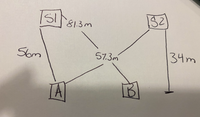Question
A violinist on stage plays a middle C note of 262HZ on a day when the speed of sounds is 343m/s. The sounds is emitted in unison from two speakers in the picture. Two people stand at the point A&B in the picture, distances shown below. Which of the two people will hear completely destructive interference if any? Justify your answer.

Transcribed Image Text:132
113m
Som
57.3m
34m
Expert Solution
This question has been solved!
Explore an expertly crafted, step-by-step solution for a thorough understanding of key concepts.
This is a popular solution
Trending nowThis is a popular solution!
Step by stepSolved in 6 steps

Knowledge Booster
Similar questions
- Microwave ovens typically cook food using microwaves with frequency 2.45 GHz. What is the corresponding wavelengh of these microwaves in cm?(ans: 12.2cm) An oceanic depth-sounding vessel surveys the ocean bottom with ultrasonic waves that travel 1530 m/s in seawater. If the time delay of the echo is 6 seconds, what is the depth of the water? (ans: 4590 m) Show workarrow_forwardTwo identical speakers are initially equal distancesfrom a listener . Thelistener hears a sound maximum (constructiveinterference). When the upper speaker is moved backby a distance d = 2 m, the listener hears a soundminimum (destructive interference). What is thelongest wavelength the soundwaves could have?arrow_forwardNeeds Complete typed solution with 100 % accuracy.arrow_forward
- A 1,720-Hz tone is played on a stereo in an open field. A person stands at a point that is 4 m from one of the speakers and 4.4 m from the other. What must the minimum wavelength be for the person to hear the tone? (Hint: because of interference, two waves add constructively or destructively. If the sound is heard the interference must be constructive. For interference to be constructive, the difference in distance must be a multiple of the wavelength. That is, the difference in distances from the speakers must be 1 wavelength, two wavelengths, three wavelengths, etc.)arrow_forwardAn interference pattern is setup with two point sources of the same frequency vibrating in phase. A point on the second nodal line is 25.0 cm from one source, 29.5 cm from the other source. The speed of the waves is 7.5 cm/sec. Calculate the wavelength and the frequency of the sources.arrow_forwardTovi is playing a flute and Dawn is playing a violin. At the beginning of the performance, they tuned their instruments by ear, so the difference between the fundamental frequencies of the A notes played on each instrument was less than 1 HzHz. At the end of the performance, they measured the A note fundamental frequencies of their instruments using a device that measures sound frequency with uncertainty 0.05 HzHz. Dawn's A was 441.8 HzHz and Tovi's was 439.3 HzHz. What is the beat frequency heard when Dawn and Tovi simultaneously play the A note at the end of the performance?arrow_forward
- What is the resultant sound level when an 81-dB sound and an 87-dB sound are heard simultaneously? This question is in the library, but, some of the answers is not visible. Some of the values are not viewable. I, and anyone else who wants to use it, need a copy that is fully readable. I should not have to "use up" my questions getting clean images like this.arrow_forwardSuppose a Speaker is at (0, a.4)m. An Identical opeaker, Connected to the same amplifier is at l6.4,0) M. Both Speakers are putting out a scrund with the same frequency and phase. Find the x-value of a point of construcHve interference between (0,0) and the Speaker on the x-axis, regardless of frequency .arrow_forwardA 1,720-Hz tone is played on a stereo in an open field. A person stands at a point that is 4 m from one of the speakers and 4.4 m from the other. What must the minimum wavelength be for the person to hear the tone? (Hint: because of interference, two waves add constructively or destructively. If the sound is heard the interference must be constructive. For interference to be constructive, the difference in distance must be a multiple of the wavelength. That is, the difference in distances from the speakers must be 1 wavelength, two wavelengths, three wavelengths, etc.)arrow_forward
arrow_back_ios
arrow_forward_ios